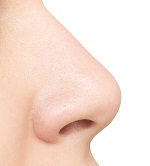
I'll bet most people don't realize that when you breathe through your nose, you do so more from one nostril than the other and your body knows to switch to the other nostril every few hours. I had no idea. I'm only aware of any difference in my nostrils when I'm congested!
This nasal cycle is controlled by the autonomic nervous system which also controls things we don't think about like heart rate and breathing. Our bodies deliberately send more blood to an erectile tissue between the two nostrils to increase its size and direct the air flowing through one of the nostrils. After a few hours, the airflow switches to the other nostril.
Why do we do this? Some scientists believe the alternating airflow allows each nostril to maintain optimal moisture levels so no one side gets dried out. It may also protect against respiratory infections or allergies.
Others believe it's tied to our olfaction or sense of smell. It's possible that the quicker and slower airflow in each nostril optimizes us to the vast range of smells. Some smells take longer to detect and transmit to the brain.
But there's no easy answer because our nasal cycle changes with our body's position and age. Right handed people appear to breathe more through their left nostril. The cycle may also be related to heart rate, blood pressure, blood glucose levels, how much we blink, autism, fever, and much more.
The reason we're aware of breathing more through one nostril when we're sick is that when we're congested, the side with less airflow just feels more blocked. Really, so much of this function is a mystery.
The next time you have nothing else to think about, see which nostril you are using more. Maybe one day we'll know why this happens and it'll lead to some pretty useful treatments.
More Information
Here's The Frustrating Reason Only One Side of Your Nose Gets Blocked at a Time
Though you may not pay attention to it unless you're sick, you're always breathing more heavily from one nostril than the other. During the day, the sides switch and the other nostril goes into 'work mode', but why?...
The human nasal cycle.
The physiologic phenomenon of alternating congestion and decongestion of the nasal airways was studied by rhinomanometric techniques...
Measuring and Characterizing the Human Nasal Cycle
Nasal airflow is greater in one nostril than in the other because of transient asymmetric nasal passage obstruction by erectile tissue. The extent of obstruction alternates across nostrils with periodicity referred to as the nasal cycle. The nasal cycle is related to autonomic arousal and is indicative of asymmetry in brain function. Moreover, alterations in nasal cycle periodicity have been linked to various diseases. There is therefore need for a tool allowing continuous accurate measurement and recording of airflow in each nostril separately. Here we provide detailed instructions for constructing such a tool at minimal cost and effort...